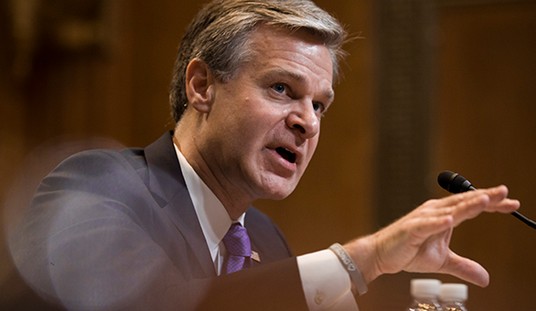This is shocking at first blush, as we had 36,000 new cases yesterday and topped out in the mid-40,000s last week. Fauci’s painting a picture here in which that number more than doubles — soonish. Hard to believe.
But then you remember how exponential growth works, and, ah, yeah. A hundred thousand a day seems plausible near-term if if if things don’t change.
Things have already begun to change, though.
NEW: Dr. Fauci says he “would not be surprised” if the US has 100,000 new coronavirus cases a day “if this does not turn around.”
“It could get very bad,” he adds. pic.twitter.com/R2tDY59QaI
— MSNBC (@MSNBC) June 30, 2020
Change came to Arizona last night when Gov. Doug Ducey ordered bars, gyms, and theaters closed for 30 days, an obvious attempt to target transmissions among young adults especially. In Texas, local leaders are lobbying Gov. Greg Abbott for authority to issue local lockdown orders to slow the rising outbreaks in major cities. Florida and Los Angeles County ordered beaches closed for July 4 weekend, which seems like overkill to me given how unlikely transmission outdoors appears to be but which, I suppose, will help at the margins.
Fauci’s presumably worried that it’s too little, too late, that the new outbreaks may already be so widely seeded that even a full lockdown now — which isn’t in the offing — to slam the brakes on transmission by shuttering businesses would still leave us “coasting” further upward in new infections until the spread finally begins to slow. States “need to follow the guidelines that have been very carefully laid out with regard to [reopening] checkpoints,” he testified today. “What we’ve seen in several states are different iterations of that, perhaps maybe in some, they’re going too quickly and skipping over some.”
I remember complaining in April, though, that he and Birx were conspicuously reluctant to call out states like Georgia that moved quickly to reopen despite not having met the guidelines for reduced transmission that the White House laid out. (Those states were aided in that effort by Trump, who had no intention of letting his own guidelines interfere with the reopening effort.) Fauci could have named ’em and shamed ’em if he looked at the data and saw that some states were reopening prematurely. He declined to do so, I assume, because he didn’t want to be further on the outs with the boss. Now we are where we are. We’ll see if he’s any more forthright about identifying scofflaw states during the next reopening attempt.
Meanwhile, the CDC’s outlook on COVID-19 is grim. We couldn’t effectively conduct contact tracing at this point even if we had the ability and the will, said deputy chief Anne Schuchat. We’re facing a forest fire, not “embers,” as the White House has recently taken to describing the current situation, and contact tracing doesn’t work in those circumstances:
“We’re not in the situation of New Zealand or Singapore or Korea where a new case is rapidly identified and all the contacts are traced and people are isolated who are sick and people who are exposed are quarantined and they can keep things under control,” she said in an interview with The Journal of the American Medical Association’s Dr. Howard Bauchner. “We have way too much virus across the country for that right now, so it’s very discouraging.”…
“This is really the beginning,” Schuchat said of the U.S.’s recent surge in new cases. “I think there was a lot of wishful thinking around the country that, hey it’s summer. Everything’s going to be fine. We’re over this and we are not even beginning to be over this. There are a lot of worrisome factors about the last week or so.”
Thirty-five states now have estimated transmission rates of 1.0 or higher, signifying that the number of infections is growing there, not shrinking. Yesterday WaPo described one factor that may be contributing to that: Although studies are still preliminary, it seems that SARS-CoV-2 has mutated over the past few months into … a more infectious virus. There’s no evidence that coronavirus 2.0 is deadlier than the original, but it does appear to spread more quickly. Gulp:
[T]he switch occurred in the part of the genome that codes for the all-important “spike protein” — the protruding structure that gives the coronavirus its crownlike profile and allows it to enter human cells the way a burglar picks a lock.
And its ubiquity is undeniable. Of the approximately 50,000 genomes of the new virus that researchers worldwide have uploaded to a shared database, about 70 percent carry the mutation, officially designated D614G but known more familiarly to scientists as “G.”…
At least four laboratory experiments suggest that the mutation makes the virus more infectious, although none of that work has been peer-reviewed. Another unpublished study led by scientists at Los Alamos National Laboratory asserts that patients with the G variant actually have more virus in their bodies, making them more likely to spread it to others.
Is it possible that the mutated virus is less lethal than the original? The great mystery in America’s data right now is why cases keep climbing while deaths keep declining. It may be a simple matter of timing, with deaths set to begin rising soon among people who were infected a few weeks ago. It may also be an artifact of the age of people who’ve been infected recently, with young adults overrepresented among new cases. (Reportedly almost one-third of the ICU patients in one Houston hospital system right now are under 50.) As they pass the virus to their older relatives, deaths will soar. But if in a few weeks we’re not seeing the rise in deaths that we’d expect from an outbreak of the magnitude we’re experiencing, thoughts will turn to alternate explanations. Remember that some doctors in Italy have already alleged that the virus is losing its potency. We may begin to reckon with that possibility in mid-July if deaths stay flat.
Here’s Fauci elsewhere during this morning’s testimony insisting that bars are an especially dangerous environment, a conclusion Abbott arrived at as well. It makes sense, and not just because they’re indoor spaces where masks necessarily need to be off. Inhibitions drop as the booze flows, which means people let down their guard about social distancing. And the physical space of the bar itself, with people crowded together talking and shouting drink orders at the bartender, leads inevitably to the same air being breathed by many.
Dr. Fauci: "Congregation at a bar inside is bad news. We really got to stop that, right now, when you have areas that are surging like we see right now” pic.twitter.com/LvFQsF3AAC
— NBC News (@NBCNews) June 30, 2020







